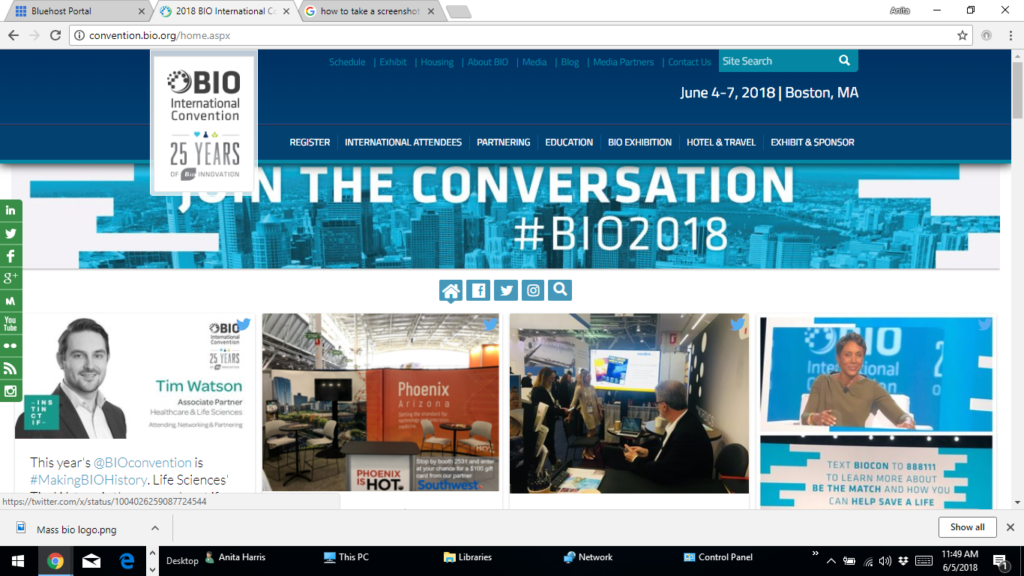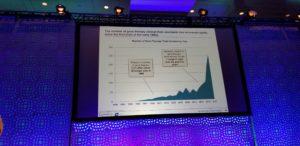
 I’ll be posting more soon about the 2018 Biotechnology Innovation Organization’s International Convention, where I spent the day on Monday, but thought the following press release might be of interest. Despite the glowing industry review, many sessions dealt with difficulties the industry is facing. The release follows.
I’ll be posting more soon about the 2018 Biotechnology Innovation Organization’s International Convention, where I spent the day on Monday, but thought the following press release might be of interest. Despite the glowing industry review, many sessions dealt with difficulties the industry is facing. The release follows.
–Anita M. Harris
A study released on June 5 at the BIO International Convention in Boston shows that the U.S. bioscience industry has reached $2 trillion in annual economic impact while maintaining accelerated venture capital investment and job growth numbers. Among U.S. technology sectors, the bioscience industry has held a leading position as an economic driver and job generator.
The report, Investment, Innovation and Job Creation in a Growing U.S. Bioscience Industry 2018, finds U.S. bioscience firms directly employ 1.74 million people, a figure that includes more than 273,000 high-paying jobs created since 2001. The average annual wage for a U.S. bioscience worker reached $98,961 in 2016. These earnings are more than $45,000 greater, on average, than the overall U.S. private sector wage. The report further shows that since 2014, the bioscience industry has grown by 4.4 percent with four of its five major subsectors contributing to this overall job gain.
For the first time, the biennial report includes a full assessment of the economic impact of the bioscience industry and finds its total economic impact on the U.S. economy, as measured by overall output, totaled $2 trillion in 2016. This impact is generated by the direct output of the bioscience industry combined with the indirect (supply chain) and induced (employee spending) impacts. The industry and its associated economic output support 8 million jobs throughout the entire U.S. economy through both indirect and induced effects.
“This report highlights the enormous economic impact delivered by our industry. This strong performance is due to the vital and wide-ranging collaborations between industry partners, universities, and policymakers that provides a business climate that supports the development of innovative bioscience products and high paying jobs,” said Jim Greenwood, President and CEO of the Biotechnology Innovation Organization.”
 The report also takes the pulse of the broader U.S. innovation ecosystem for bioscience companies and finds it advancing with positive results. The U.S. is experiencing strong gains in bioscience venture capital funding, growth in patents, a recent ramp-up in bioscience-related university R&D expenditures and increasing research funding from the National Institutes of Health (NIH).
The report also takes the pulse of the broader U.S. innovation ecosystem for bioscience companies and finds it advancing with positive results. The U.S. is experiencing strong gains in bioscience venture capital funding, growth in patents, a recent ramp-up in bioscience-related university R&D expenditures and increasing research funding from the National Institutes of Health (NIH).
“The bioscience industry is vital to the U.S. not only as an innovation engine that is improving lives, but also as a major economic driver that is consistently generating high-quality jobs and significant economic output across the nation,” said Ryan Helwig, Principal and Project Director with TEConomy Partners.
The state-by-state industry assessment is the eighth in a biennial series, developed in partnership by TEConomy and BIO, presenting data on national, state, and metropolitan area bioscience industry employment and recent trends.
Additional highlights from the industry economic analysis include:
- The industry is a major economic driver and is well distributed across U.S. states and cities:
- 41 states experienced net job growth in the biosciences between 2014-2016
- 38 states and Puerto Rico have an employment specialization in at least one bioscience subsector
- 213 of 383 U.S. metropolitan areas have at least one bioscience specialization
Highlights from the analysis of the innovation ecosystem for the bioscience industry include:
- Strength in recent venture capital and patenting trends:
- Venture capital investments have reached new highs. More than $66 billion in venture capital was invested in bioscience companies during the 2014 through 2017 period, including a new annual high in 2017 at $20 billion invested.
- Innovation continues to drive the biosciences, since 2014 the U.S. has increased patent totals in bioscience-related technology classes by nearly 5 percent, or 1.6 percent per year, on average. 2017 had a total of nearly 27,000 patents awarded to U.S. inventors, another new high.
- Growth for academic biosciences R&D in 2016
- After several years of concerns raised about the declining and/or flat NIH research budgets and the subsequent effects on academic and other research, NIH funding is back on the rise. There have been budget increases sustained each of the last three years.
- Across America’s colleges and universities, the pace of R&D spending in bioscience-related research areas has increased. Following a 1.5 percent decline in 2015, academic R&D expenditures in the biosciences increased 5.5 percent to $42 billion in 2016.
The TEConomy/BIO report includes individual profiles for all 50 states, the District of Columbia and Puerto Rico, and can be found on the BIO website at bio.org/jobs2018.
About BIO
BIO is the world’s largest trade association representing biotechnology companies, academic institutions, state biotechnology centers and related organizations across the United States and in more than 30 other nations. BIO members are involved in the research and development of innovative healthcare, agricultural, industrial and environmental biotechnology products. BIO also produces the BIO International Convention, the world’s largest gathering of the biotechnology industry, along with industry-leading investor and partnering meetings held around the world. BIOtechNOW is BIO’s blog chronicling “innovations transforming our world” and the BIO Newsletter is the organization’s bi-weekly email newsletter. Subscribe to the BIO Newsletter.
About TEConomy
TEConomy Partners, LLC is a global leader in research, analysis, and strategy for innovation-based economic development. Today we’re helping nations, states, regions, universities, and industries blueprint their future and translate knowledge into prosperity. The Principals of TEConomy Partners include the authors of the prior Battelle/BIO State Bioscience Development reports, published since 2004. For more information, please visit http://www.teconomypartners.com.



